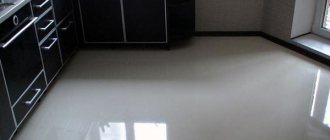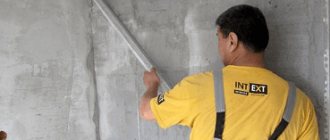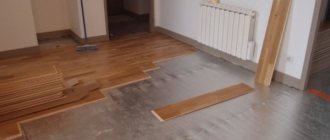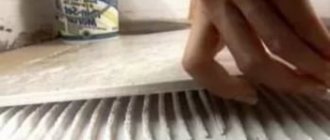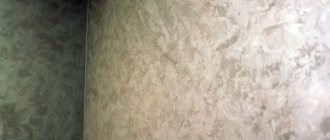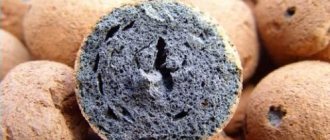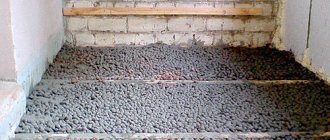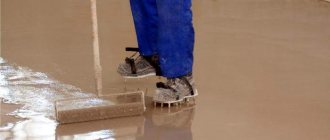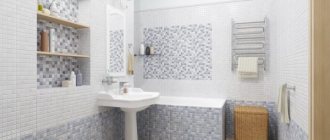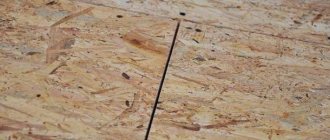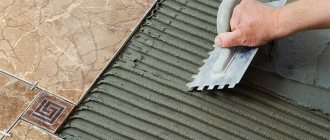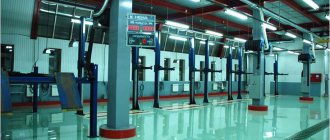A self-leveling floor is a very effective achievement of construction technology. However, a do-it-yourselfer should take it on for himself after thinking hard. The effectiveness of a spreading base for finishing flooring does not lie in its cheapness - the cost of components and equipment is significantly higher than for a traditional cement-sand screed. And not in the simplicity of the technology - self-leveling flooring is much stricter in terms of the qualifications and integrity of the performers. And not exactly leveling - an experienced worker will make the cement-sand base along the beacons no more inclined or humpbacked, and without rushing. And not in strength - the filling is weaker than concrete.
A self-leveling self-leveling floor has advantages that more than cover these disadvantages:
- The technological break after screed formation is reduced from 20-40 days to 8-48 hours. There is no need to explain what this means for mass construction or renovation of residential apartments.
- The cured coating is waterproof, i.e. has high hygienic properties.
- The texture of the finished surface is smooth, which, in combination with the previous one, allows you to lay almost any finishing coating without a cushion: it will not rub off while “playing”, will not become damp and will not rot.
- The elasticity and plasticity of a self-leveling floor base is several times higher than a purely mineral one, and its specific gravity is less, which allows some types of it to be poured onto an existing wooden floor.
Therefore, it makes complete sense for those who still want to make a self-leveling floor with their own hands, to talk about some of the subtleties and nuances of this work, which are not sufficiently covered in the available sources or are completely hushed up. It is precisely because of their ignorance that home craftsmen who take up the “pouring” experience failures. But, alas, it is impossible to remake the “hedgehog” or “wave” covering: you have to knock down the entire bedding down to the supporting slab, which is tantamount to a major overhaul of the floor. From what without extreme necessity - God forbid!
General remarks
First, all the methods described below will create a surface intended for finishing flooring. Self-leveling floors are not intended to be painted or used independently without a finished floor covering. Decorative self-leveling floor, incl. and the increasingly popular 3D floors are a completely separate topic.
Secondly, you must work with a partner. And not with a random person, but with a good friend with whom you have worked together. If the next batch does not arrive exactly in time for its pouring (and the time is calculated in minutes), then the floor will not be level, but stepped.
Third - for premises with an area of more than 40 square meters. m. or a length of more than 8 m is strictly not recommended for inexperienced workers. In such rooms/corridors it is impossible to do without temperature, expansion and technological seams. It’s easy to make a seam, but where – you need either the experience of a very skilled craftsman, or the exact calculation of a specialist builder.
Leveling the floor with a self-leveling mixture consists of the following steps:
- Revision of the underlying surface;
- Selecting the alignment method;
- Selecting a suitable mixture;
- Calculation of the thickness and volume of coating layers;
- Calculation of mixture consumption;
- Preparing the base;
- Preparation of the working mass (kneading);
- Pouring the floor;
- Laying flooring.
We do not describe the last stage here, because flooring is also a separate issue.
Advised by professionals
In order to obtain the highest quality surface at an affordable price, experts use some techniques.
So, if the base base is not too crooked to purchase medium or basic bulk compositions, but not so smooth as to get away with just a finishing coating, the situation can be corrected. You just need to sand the surface using a sanding machine. This will smooth out unevenness and save on materials.
In order not to purchase primer compounds, you can make them yourself from a small amount of dry compounds for self-leveling floors. The mixture is diluted and then applied to the base with a roller. When the product has dried, you can pour the finishing floor.
Audit
Homemade dust collector
Before the inspection, you need to remove all furniture from the room and remove baseboards. If we are not pouring on a wooden floor, remove the floor covering. Next, you need to thoroughly sweep the floor twice with a hard-bristled brush, after sprinkling with water. Finally, vacuum; To prevent damage from stone dust, a household vacuum cleaner is connected through a factory or homemade (see figure on the right) dust collector.
Self-leveling mixtures are quite tolerant in the state of the underlying base. In most cases, they can be applied to the “bedding” unless it is an emergency – you just need to choose the appropriate mixture and method of its application. For the convenience of this very important procedure, it is advisable to evaluate the condition of the “litter” according to the following parameters:
- Strength;
- Humidity and moisture permeability of the base;
- Indoor humidity;
- Surface evenness, local and general;
- Load bearing capacity;
- Will there be a heated floor?
- Surface wear.
Strength
The strength of reinforced concrete floors in professional construction is determined by various types of impact or pressure tools: Kashkarov hammer (manual), Schmidt hammer (electronic with digital display), ri-ri device (scratch). The essence of the method is the same: a tip made of a solid material of a strictly defined size and configuration is pressed into concrete with a precisely dosed force, and the strength is judged either by the degree of its penetration or by the size of the mark from it.
Checking the hardness of the base with a glass cutter
You don’t need to accurately determine the strength of the base for yourself. You just need to know whether it is suitable for pouring without additional processing or not. The easiest way to do this is to use a roller glass cutter. If you have never cut glass before, “scratch” the fragment and remember the force at which the scratch appears.
Approximately the same force should be used to move the roller along the concrete. If the width of the scratch does not exceed the width of the roller (see figure), there is no need to harden the surface of the base. If the roller fails, either a thorough primer or surface repair is needed.
Base moisture
Check to see if the base is damp with a piece of plastic film measuring approximately 1 square meter. m. The test is done at a temperature of 15-25 degrees with the heating turned off, in clear, dry weather. The technique is as follows:
- Ventilate the room with the windows wide open for at least an hour.
- The windows and doors are closed, the film is laid in the center of the room, and its edges are pressed down with slats with weights.
- The middle of the film is pulled up slightly.
- They wait for a day.
If the film remains dry, great, you can fill it without anything. If there is perspiration, you need to prime it twice or thrice. If the fumes have collected in drops, in addition to the primer, you will have to lay waterproofing before pouring the floor, or it is better to refrain from leveling altogether for now and repair the base.
Room humidity
For a self-leveling floor, what matters is not the relative humidity (this is a physiological parameter), but the absolute content of water vapor in the air. Absolute humidity of more than 2% by volume is unacceptable for gypsum-based mixtures suitable for pouring onto wood floors.
Everything is clear with kitchens, hallways and bathrooms - they need a moisture-resistant cement-based floor. In living rooms, you can roughly determine the linen: if in the off-season, when the temperature in the room with the heating turned off does not exceed 22 degrees, the linen does not get damp, i.e. The dew point is not reached, the room is suitable for “filling”.
Base evenness
The size and depth of local (local) irregularities - chips, potholes, seams between slabs - are determined simply: depth - with an even piece of lath or a special tool - a rule and a mechanic's ruler; the share of the area of local irregularities in the total - visually. With shrinkage hollows or bulges the situation is more complicated; they are often simply not noticeable, but manifest themselves in the fact that the seemingly precisely calculated amount of mixture is suddenly not enough, and all the work goes down the drain.
A method for independently identifying the general unevenness of the base is illustrated in the figure. The procedure is as follows: in different places, along, across and diagonally, we apply a regular bubble level 1 m long to the floor. We slip a match or a sliver under the lowered end until the bubble stands exactly between the risks. The amount of unevenness per 1 linear. m in this area will be equal to the size of the gap between the end of the level and the floor. Most often, there is a hole 3-7 mm deep in the center of the room.
Detection of shrinkage unevenness of the floor
Load bearing capacity
Since the self-leveling floor in many cases (wood, cinder block, vermiculite, shell rock, foam and aerated concrete) rests on a weaker base, not only its overall load-bearing capacity, with a uniform load on the square, is important, but also its resistance to punching. Wood and EPS are quite durable in this regard, but you still can’t pour the floor on them directly; you need to pour it on a fiberglass mesh. It can float up, so the mesh is grabbed in increments of 100-250 mm with drops of silicone or mounting adhesive.
For porous materials, this is not enough; you will have to put a welded reinforcing mesh made of 3-6 mm wire under the filling. The chain-link is not suitable, because its nodes are free and will not save you from being pressed. There is, however, one positive point: the mesh can be laid on a sand cushion half the thickness of the wire, this will significantly reduce the consumption of expensive “filling”.
Warm floor
There is an unpleasant nuance here: pipes in a leveler that has not yet hardened can also float; The same applies to all other walled communications. To avoid floating, the pipes are filled with water at room temperature before filling and secured with silicone, like a fiberglass mesh. Before pouring, cable ducts are attached to the base in a standard way.
Superficial wear
Superficial wear is, simply put, whether the floor itself is dusty or not. It is determined a day or three after the inspection, because before it there was a thorough cleaning and dust removal. If the floor in an enclosed space becomes dusty again, clean it again, and immediately impregnate it with a deep-penetrating liquid primer.
The primer is applied with a fibrous (shaggy) roller, without making puddles. It is better to take a primer composition that forms a film. Once dry, try to separate this film from the base. If it lags, rip it all off and prime it again. If the film does not stick firmly to the base even on the third layer, there is nothing you can do, you need to repair the ceiling, and only then refill it.
Epoxy and polymer resins
Epoxy and polymer self-leveling compounds are used to produce high-quality floors, ideal for both civil and industrial premises.
They are used in shops, offices, laboratories, shopping centers, medical offices and industrial plants, as well as in residential buildings.
- Epoxy flooring resin is stable, durable, easy to clean, hygienic, safe and requires minimal maintenance.
- It can be applied to existing floors, updating the surrounding interior in a short time. This is a universal, smart, modern and inexpensive solution.
- The compound used to make this type of flooring contains hardeners and other components that guarantee high quality.
- This resin can be applied to ceramic and porcelain tiles, as well as concrete or wood surfaces.
- After installation, the floor dries quickly and immediately becomes a glossy, waterproof, durable floor covering that provides a remarkable aesthetic effect.
Self-leveling resin floors come in a variety of colors and provide an excellent finish. Upon request, surfaces can be decorated with images, inscriptions, symbols, logos, photographs.
How to level
Compositions that are fluid enough to self-level to a smooth horizontal plane are called leveling or leveling compounds. Different manufacturers give the maximum thickness of the leveling layer at 12-15 mm, but this is under ideal conditions, as discussed below. It is highly advisable to limit yourself to a level layer no thicker than 5-6 mm. This is also important because the level is very expensive.
Most often, a leveler is placed under the level - a coarser mixture. If you dump a batch of leveler out of a bucket, it will just harden in a heap, only it will sag a little and spread out. Therefore, the leveler has to be additionally leveled under the level, but it is cheaper, and the layer thickness can reach 60 mm for cement-based compositions and up to 150 mm for gypsum-based ones. With a leveler, the thickness of the level layer can, with careful work, be increased to 2-3 mm.
Adjustable beacon for filling with leveler
Looking ahead, let's say that when pouring leveler, screw beacons provide great assistance, see fig. The solution is poured along the lower edges of their threaded pins, which were set in advance using a cord or a laser plane builder. The beacons are removed after the solution has set for a time sufficient for technological movement, i.e. when it will be possible for one person to walk on it without a load.
The technological setting time is indicated in the instructions for the mixture. Typically this is about 8 hours. It must be observed; if, for example, you forget or give up and leave it until the morning, the solution will completely harden, and the beacons will no longer be pulled out.
Based on all of the above, based on the results of the audit, you can choose a single-layer or two-layer method of leveling the floor:
- Smooth, no more than 3 mm of total unevenness, solid base - with one layer of leveling.
- The base is strong, but very uneven, with shifts in the slabs, deep potholes - level the layer according to calculation, see below, then level. We calculate the depth from the top of the largest convexity.
- Wooden base - a layer of gypsum leveler of at least 30 mm, then also a gypsum level to calculate the thickness, see below. We use gypsum mixtures because their specific gravity is 20 percent lower than that of cement ones. The leveler and level are with fiber filler, also see below.
- For insulation in dry rooms - gypsum mixtures over fiberglass mesh or reinforcement.
- In wet ones, cement mixtures are used, but always on a reinforcing mesh, due to the heaviness and less plasticity of cement compositions.
Note: you cannot apply a layer of leveling agent just to hide the highest bump. To avoid explaining for a long time, try putting a brick in a container and filling it with liquid mud; it is similar in consistency, adhesion and fluidity to leveling agent. In order for the contours of the brick to stop appearing, you will have to pour quite a lot in excess of its height.
3D floor manufacturing process
Step 1. The base is thoroughly cleaned of dust and debris and, if necessary, leveled. All cracks are sealed with building mixtures or sealant.
The subfloor is vacuumed
Step 2. The floors are sanded with a sanding machine. This will help get rid of the bumps on them.
Sanding the base
Step 3. The epoxy primer mixture is mixed and applied to the rough base. The primer is applied in a thin layer without leaving any spaces. The drying time for this layer is 24 hours.
Applying epoxy primer mixture
Step 4. If there are still any cracks or potholes on the surface, they are puttied.
Puttying base defects
Step 5. Mix the mixture to create a base layer. Then it is poured onto the prepared base and carefully distributed over it using a wide spatula.
Preparing the mixture for the base layer
Pouring the prepared mixture
Spreading the mixture with a spatula
Step 6. In order to remove air from the mixture, it is rolled with a needle roller. The layer is then dried for 24 hours.
Rolling with a needle roller
Step 7. Cutting, fitting and gluing of the film with the pattern are carried out. The film must be carefully smoothed over the surface of the base layer and there should be no bubbles on it. And the image must be adjusted literally down to the millimeter.
Unpacking film rolls
The film is being tried on
The film with the pattern is smoothed over the surface
Pasting film with a pattern
Step 8. The last, finishing layer of the self-leveling floor is poured onto the surface of the film. It is transparent and the design will be clearly visible through it.
Filling the finishing layer
Step 9. The layer is also leveled with a wide spatula and then rolled with a needle roller. After finishing the work and drying the last layer, the floors can be coated with a protective varnish.
The finishing layer is leveled
Another roll with a needle roller
Prices for self-leveling floors "Starateli"
self-leveling floors prospectors
Blend selection
The manufacturer of the mixture as a selection factor is not of paramount importance . Recognized industry leaders - Knauff, Ceresit, Siltek, Vetonit, Staratel - have recently been intensely squeezed by many outsiders, and, judging by the reviews, their products, with strict adherence to technology, cause even fewer complaints. We emphasize - if you do it exactly according to technology.
The main secret of self-leveling floors is not “secret” polymer additives and plasticizer additives. The main thing is the quality of mineral materials and their precise fractionation, and this can, in principle, be achieved in a barn using simple equipment. For example, for a level you need cement of a grade of at least 500. Why? Its microgranules are smaller. Therefore, you need to choose a mixture, first of all, based on the presence of accurate and detailed instructions, on the back of the bag or on the company website. What should be reflected in it will be clear after reading the article.
In general, the choice is determined, in addition to price, by the properties of the base and the premises. Something has already been said about them, now let’s take a closer look.
As already mentioned, dry ready-mixes for self-leveling floors are cement or gypsum based. The former are heavier and more fragile, but are moisture resistant. The latter are lighter and more flexible, but are afraid of moisture.
The next point is the polymerizing binder. It can be either polyurethane (solution density is about 1.20 kg*l for gypsum mixtures and about 1.35 kg*l for cement mixtures) or epoxy (1.40 and 1.65 kg*l, respectively). Epoxy mixtures are stronger, but less fluid and plastic; they are advisable to use for levelers or in rooms with a loaded floor - garage, bathroom, etc. It is better to take a polyurethane level for residential premises if it fits on the leveler; if directly on concrete - epoxy.
Then, the fiber filling. It (polymer or fiberglass) can either be added to the mixture or not. The first, naturally, is more expensive, but the elasticity and ductility of the finished coating increases significantly. Mixtures with microfiber filling absolutely must be used for filling insulation with fragile insulation materials (practically any except EPS; its load-bearing capacity for a dispersed load is 0.5 MPa or about 500 kg per sq. m), for dusty or wooden floors. This does not cancel the grids mentioned above; the required mechanical properties of the finished coating are ensured only by a set of technological measures.
Next is the flooring. Under foam-based linoleum, marmoleum and tiles, you can get by with just one leveling agent. Under laminate, parquet and cork you also need a leveling layer. Due to its increased plasticity, it will affect the deformation of the wood, and it will not rub against it, because the underlying surface is smooth.
And finally, the last factor is the survivability of the solution, i.e. the time during which it is suitable for work. This time varies for different mixtures within 15-40 minutes. You need to know that before the end of pouring, the entire poured surface must still be “live”; only a few professionals can manually fill a large area floor up to the “mirror” piece by piece.
At the same time, at the maximum pace of work and full coordination of actions with a partner, manual cyclic pouring of a 10 mm layer of floor area of 12 sq. m. takes at least 20 minutes, and 16 sq. m. m. - half an hour. Deaeration (see about pouring, below) will require about 5 more minutes; The capacity of one manual (drill with a mixing attachment) batch should not be more than 30 liters. That is, in almost any living room, quick-hardening mixtures are applicable only if you have a continuous automixer and a pump for supplying the solution, the rental of which is expensive, because This equipment wears out quickly.
Note: the viability of the solution can be increased by 15-20% by mixing the maximum amount of water according to the manufacturer's specifications. But - only in the optimal temperature range, see below.
Quality of produced materials
Despite all the commonality of dry mixtures, each manufacturer uses its own recipe, that is, its own ratio of added modifiers. This determines their different behavior.
You can form a preliminary opinion about the quality based on the consumption of the composition in its finished form, which is indicated by the manufacturer on the packaging.
In the case of a high-quality mixture, on average, at most 1.6 kg/m2 should be consumed per 1 mm layer. The strength and speed of complete hardening depends on the declared volume of water required to prepare the solution, and the less it is, the better the quality.
Calculation of layers
First of all, let’s calculate the thickness of the “zero” layer, i.e. one that will give a smooth horizontal surface, provided that the composition is absolutely fluid. Next, using the “zero” thickness, we will calculate the required thickness of the leveling layer itself. Thus, we will reduce the real complex relief of the base to some imaginary horizontal plane.
Why such difficulties? The fact is that any instructions for self-leveling compounds give the specific consumption of the dry mixture, in kg*sq. m, in a layer of 1 mm, based on pouring onto a flat horizontal surface. Actually, this parameter characterizes the ability of the mixture to spread, and it is difficult to calculate the true consumption on a real surface using it; you have to give an extra technological margin.
For mass construction this is not so important - there the customer will pay for a known excess or for the actual cost of completion. And the surplus will go to the next object, not without benefit for the contractor. It is almost impossible for a homemaker to sell the entire remaining bag of expensive mixture, the shelf life of which is about to expire. Half a bag is generally impossible once the packaging is opened. Therefore, consumption must be calculated accurately.
Calculation based on “zero” assumes that the work is done in stages: fill in “zero”, wait for shrinkage. Fill the level with a minimal layer. Completely frozen, but the “bricks” are still visible? It’s okay, pour at least a little more until you get a “mirror”; “zero” has already given the required strength. Sometimes this method is also used by professionals in especially critical cases or when a serious customer is ready to pay for downtime, as long as it is done perfectly.
Zero
We take the largest and smallest of the depths of local irregularities and find the average. Let's say the measurements gave 5 and 3 mm, then the average will be 4 mm. We multiply the resulting value by the apparent ratio of the pothole area to the total floor area to obtain the effective depth of the local depressions. Let’s say that the depressions apparently occupy a quarter of its area, then the effective local depth in our case will be 1 mm.
Now let's determine the effective depth of the shrinkage valley. In the vast majority of cases, it covers the entire floor area, and its configuration is similar to a segment of a sphere. Therefore, we simply multiply the depth of the hollow by 0.7. Suppose the measurements were 6 mm, then its effective depth will be 4.2 mm.
The total thickness of the zero filling layer will be equal to the sum of the effective local and general depths. In this case – 5.2 mm, but that’s not all, we have only just reached the virtual plane. The solution is not absolutely fluid and, in order to avoid the “brick-in-the-mud” effect, a covering layer must be poured onto the resulting surface. It can be either made from leveling agent or leveling, after the leveling agent has hardened. The latter is preferable not only in terms of smoothness, but also because it is cheaper: the minimum leveling layer is from 3 mm, and the leveling layer is from 1 mm.
Cover
The thickness of the covering layer is calculated quite simply. We take a completely reliable value - specific consumption according to the manufacturer; it lies in the range of 1.4-2 kg*sq.m*mm, multiply by 2 and round to a higher value. This empirical formula gives nothing more than the number of layers of minimum thickness, according to the specification for the composition, necessary for the “bricks” to be completely covered with “dirt”. Let's say we have previously selected a composition with a specific consumption of 1.8 kg*sq.m*mm, then we get 3.6 or, in round numbers, 4 layers. Since the minimum layer for leveling masses is 1 mm, we immediately received the power of the “blanket”.
Increases
However, it is too early to calculate consumption if mesh and/or base waterproofing is used. On the mesh we add a layer of leveling agent equal to its thickness (or half of it, if the reinforcing mesh is on a sand bed, see above), and on the insulation of the corners - leveling agent equal to the thickness of the foam corner tape, more on that later. Let's say we cast on a fiberglass mesh with a thickness of 0.38 mm, and put a tape 3.5 mm thick on the corners, then we need to add 3.88 mm to the leveler.
Bottom line
We summarize everything together for a single-layer filling, and for a two-layer filling - separately for the leveler and level. Let us assume that we are going to pour in 2 layers, then in the case under consideration we will get 5.2 + 3.88 = 9.08 or, rounded up, 9 mm of leveler, and then 4 mm of leveling layer. According to generally accepted calculation methods, it would be 12 mm and 6 mm, respectively.
Consumption
It remains to calculate the consumption per 1 m² of the selected mixture. This is where the main highlight of the method appears: we get the flow rate immediately in the dry weight of the sales material, without bothering with calculating the density of the finished solution, for which we would have to make arbitrary assumptions. We just need to multiply the calculated layer thickness by the floor area and the specific material consumption; all these values are accurate and reliable.
In our example, for a room of, say, 16 square meters. m will yield 259.2 kg of leveler and 72 kg of level. All that remains is to reduce it to bags containing 25 kg. We round them according to the rules of arithmetic, from half to more. Calculation according to our data will give 10.368 bags of leveler and 2.88 bags of level. We take 10 bags of the first and 3 of the second.
And now your homework: go to the website of any hardware store, find out the prices and calculate the savings compared to traditional estimates.
Preparing the base
The pour-on floor leveling technology is generally more forgiving of the condition of the base than conventional or dry screed. With the exception of one point - the moisture content of the base. Water vapor, pushing through the fill, destroys the polymer films between the granules of the mixture, and the coating begins to crumble. Therefore, it is highly advisable in any case, before filling, to install waterproofing with a wide vent around the perimeter so that fumes do not penetrate into the leveler. How? More on this below.
Concrete
Preparing a concrete base for pouring includes the following operations:
- Sealing cracks.
- Primer.
- Waterproofing.
- Thermal insulation and mesh laying.
The primer and mesh have already been mentioned; thermal insulation is a separate big topic. Sealing cracks with waterproofing is the same, but for filling these operations there are features that we will consider.
Small cracks are repaired using conventional methods. If there are gaping (2 mm or wider) and active ones located along the perimeter and diagonals, then you must first check using non-destructive testing methods to see if the entire ceiling is destroyed. If so, what kind of alignment is there, the house is in disrepair.
If not, then in the process of cutting cracks, cuts are made perpendicular to them with a width of 2-3 mm, a depth of 40-50 mm and a length of 150-200 mm, in increments of 200-250 mm. The cuts will create technological seams that “spread” the load. They are sealed along with the cracks.
Now about waterproofing. It is almost always needed; a zero result in a floor moisture test is a rare exception, and even then the situation can change, especially if the house is new. Firstly, polyethylene cannot be laid under a continuous covering; moisture diffuses through it. The floor filled with leveler should only breathe around the perimeter, so you need waterproofing or other special material. But before laying down the film, you need to paste over the corners.
Foam tape for gluing corners
The corners are covered with polystyrene foam tape. In addition to an outlet for fumes, it will also create an expansion joint. Foam tape is available in different types, incl. to create hidden expansion joints in concrete monoliths, but we need a special one for corners. It can be recognized by its color (not white), smaller thickness (3-5 mm) and, most importantly, by the groove extruded along the axis, along which it bends, see fig. The tape is glued with drops of silicone in increments of 100-250 mm; nitro glue can corrode it.
Tree
Wood flooring needs to be play tested first. To do this, use a plumb line in a tripod hastily made from scrap materials (pipes, slats, fishing rods) with a height of at least 1.5 m. The device is installed in the center of the room. The tip of the plumb line should almost touch the floor; a sheet of paper with a drawn cross, concentric circles, etc. is slipped under it. markers.
Then they walk around the room, monitoring the deflection of the load. More precisely, due to the slope of the floor, because the load still hangs vertically. The size of the floor play is related as the height of the suspension to the length or width of the room, depending on which direction the greatest deviation is noticed. The limit value is 1.2 mm per 1 m of the corresponding size; if more, the flooring needs to be sorted out or completely removed and poured over the base.
For example, a tripod 1.8 m high; room 2.5x4 m. The largest deviation of 2 mm in length was recorded. Overall game (4/1.8)*2 = 4.44 mm. There are 1.11 mm per 1 m of length, you can fill it.
Note: The room being tested must be completely empty.
Next, we open any board (or parquet block, or laminate slab) near the wall that is most suspicious of moisture, and inspect its underside and joists, if the flooring is laid on joists. Suddenly, traces of dampness, rot, mold, or a bug are discovered - again, we put off the leveling and start laying.
If everything is OK with the stability and integrity of the flooring, then you need to fill the cracks with sawdust mixed with liquid nails until the thickness of sour cream. You can also use ready-made wood putty, but not water-based. Roughly planed wedges are driven into wide (wider than 2 mm) cracks before puttingty and then planed flush with the surface. Now all that remains is to cover the corners with foam tape, apply waterproofing, as for concrete, and mesh, as already described. We remind you that wood leveler is needed on plaster and polyurethane with microfiber.
Kneading
To properly make a self-leveling floor, kneading is the most delicate and responsible procedure. The vast majority of irreparable errors occur at this stage, so let’s take a closer look.
Temperature
Manufacturers indicate the operating temperature range for their mixtures. As a rule, it is 15-30 degrees. A floor poured in the cold will not gain the required strength (water will begin to destroy the polymers before it evaporates) and will soon begin to crumble. Neglect of temperature conditions is one of the most common reasons leading to marriage.
Pouring in the heat is even worse - the water evaporates too quickly, and the composition does not have time to spread. The mixtures are very sensitive to excess temperature. For example, even such a proven composition as ProfLine PR-1, poured at 32 degrees, hardens with a hedgehog.
Best before date
The permissible shelf life of packaged mixtures is from six months to a year. If there is no date stamp on the bag, but there is a tick in the month box, we subtract one month, because it is unknown whether it was made on the first or last day. For example, if March is ticked and the expiration date is 6 months, then from September 1 the mixture is considered unusable, no matter what the seller says.
Note: traders try to display bags with expiring dates in plain sight.
Water
The specifications for the mixture specify the amount of water for mixing with a certain tolerance, for example, 0.28 l/kg +/- 0.03 l/kg. Admission is not given for a blunder. In favorable temperature conditions (18-24 degrees), it is used to regulate the fluidity and survivability of the solution. If the temperature is near the upper/lower limit, then due to tolerance the mixture is adjusted to the temperature. In the cold they give a minimum of water, in the heat - to the maximum. But trying to fend off an unsuitable temperature by giving too little or too much water is useless - it will still end up either “cotton wool” or “hedgehog”.
Sand
Gypsum and cement-sand mixtures are not stored, so sand for the solution will most likely have to be purchased separately. The instructions for the solution most often indicate what kind of sand is needed, and these instructions should be strictly followed. Unsuitable sand is the second most important reason that spoils the work.
If there are no such instructions, you should be guided by the following:
- You need river sand, with round granules. What is important here is the spreadability of the polymer over it; adhesion is ensured differently. The most common mistake of hacks and amateurs is buying for the sake of imaginary savings of quarry sand.
- For levelers, the sand fraction is 0.4-0.8 mm, neither smaller nor larger.
- For leveling composition – 0.25-0.35 mm.
Note: for gypsum-polyurethane mixtures, a fraction of 0.15-0.2 mm is even better, but - alas! – the cost of river sand, already expensive, rapidly increases with a decrease in fraction.
Dishes
For kneading you will need 4 containers: 2 buckets of 30 liters each or tall basins of similar volume for the actual kneading and 2 ordinary buckets for rinsing the tools, “dirty” and “clean”. It is highly desirable that the kneading utensils have rounded corners on the bottom.
Mixing nozzle for mixing self-leveling floor
Mixer
You also need more than just a mixer attachment for a drill. It should be of a spiral type, double-threaded belt and with a bumper circle at the bottom, see fig. Other attachments with extremely limited kneading time (see below) will not create a sufficiently homogeneous mixture.
Mixing technology
Knead in half-bag portions. First, water is poured into the container according to the specifications for the composition, then the dry mixture is poured. Knead with a drill at low speeds, 100-300 rpm. While kneading, move the attachment in a circle and up and down, if possible without touching the walls and bottom: vibration of the dishes sharply worsens the homogeneity of the mixture. The duration of the kneading is 3-4 minutes; it cannot be shortened or prolonged. The kneading should end just when the solution begins to ripen, see below.
Ripening
The batch must mature before use. The bottom line is that the polymer must envelop the granules of the mineral components, which, ideally, should not come into contact with each other at all, only through the polymer film. Ripening also takes 3-4 minutes. Pouring out an unripe solution is a grave mistake. In most cases, the result is, if not a “hedgehog”, then a “wave” under other favorable conditions.
Fill
Filling is the final part of the work. There is less such strictness as during kneading, but clear coordination of the actions of the master and partner is required. Fill the floor as follows:
Raquel
- The partner makes the first batch.
- As soon as it is ready, the master sets aside the first batch for ripening and substitutes another for the second batch.
- At this time, your partner quickly, for 3-4 seconds, rinses the mixer in two waters, without turning off the drill.
- The partner makes the second batch (don’t forget to rinse the mixer!), while the master dreams or gives the command.
- 20-30 seconds before the second batch is ready, the master takes the first one, pours it into the far corner, gives the empty bucket to his partner for the third batch and disperses the first batch with a special tool - a squeegee (or squeegee, see the figure on the right).
- Meanwhile, the second batch is ripening and the third is being prepared.
- The master sets the third batch to ripen, takes the ripe second batch, pours it out, and disperses it.
- The cycle is repeated and the mixing buckets are changed until the entire area is filled.
Needle roller for deaeration of self-leveling floor
Now the poured floor seems smooth, but in the layer of mortar there is an insidious fifth column hidden - air bubbles. If you forget about them, they will begin to float and the coating will turn out to be a “grater” or a lunar landscape. Therefore, the final stage of pouring is deaeration.
It is produced with a special (not for drywall!) needle roller, see fig. Pay attention to the visor above it. Its purpose is to protect not only clothes and faces from splashes, but the solution itself. Moisture from spray flying in the air evaporates intensely, especially at elevated temperatures. Falling back into the filling, they create inhomogeneities in it. They are not immediately visible, but when it has already begun to set and it is useless to do anything, a “grater” appears.
“Puncture”
In small areas (toilet, bathroom, hallway and kitchen in Khrushchev-era buildings), quite expensive squeegees with a roller (about 1000 rubles for both) are sometimes replaced with a homemade “piercing” tool - a board with nails on the handle, see fig. left. By “piercing” you can both disperse and deaerate the solution. In the first case, she is pulled; in the second, they spank her.
But already on an area of 10-12 square meters. m savings turn out to be illusory. The solution sticks to the nails, and the tool has to be rinsed every now and then. Extending the work is not a big deal here, because... You only need a few batches, but the expensive solution is wasted at a price much higher than the cost of a squeegee and roller.
Requirements for work
Making beautiful and neat self-leveling floors with your own hands is not a difficult task, but it requires a careful approach. Haste is needed here, but only in moderation, and it is only due to the fact that the mixture polymerizes quite quickly. But as for preparation, there is no need to rush here.
The process of pouring self-leveling floor
Preparatory work consists of thoroughly cleaning and leveling the base on which such a floor will be poured. The best option is a concrete screed. Such foundations cannot be installed on floors. There should be no stains of paint or grease, sand, or debris on the screed itself. In this case, the base should not be wet - the permissible level is only 4%. If the humidity is higher, the subfloor must be thoroughly dried before starting work. Otherwise, all your efforts will go down the drain.
Attention! It is better to pour self-leveling floors at an air temperature of at least +10 degrees.
Preparing the screed for installing a self-leveling floor
All cracks in the foundation must be sealed with sealant or mortar. Only in this case will it be possible to minimize the consumption of the bulk mixture. It is also recommended to sand the surface well and coat it with a primer designed for the use of mixtures to create self-leveling floors. The main thing is to pre-dust the base.
Repairing cracks in concrete floors
On a note! The self-leveling floor goes well with a heated floor system. Therefore, it is worth thinking in advance about whether it is needed in the house. And if necessary, then make it inside the screed.
Warm floor under self-leveling coating
Also, before starting work, you need to take care of acquiring all the necessary tools. These are a squeegee, containers for mixing mixtures, paint shoes, a needle roller, and a construction mixer. If 3D self-leveling floors are created, the desired design is selected in advance and printed.
Tools for self-leveling floors
Types of squeegee blade sizes
Paintshoes
